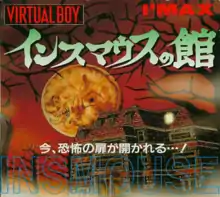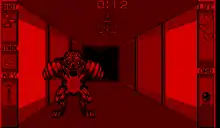Innsmouth no Yakata
Innsmouth no Yakata,[lower-alpha 1] also rendered as Insmouse no Yakata, is a 1995 first-person horror video game developed by Be Top and published by I'Max in Japan for the Virtual Boy. Assuming the role of a private detective in 1922, the player is tasked with escaping a monster-infested mansion with an artifact called the Necronomicon. The player navigates several mazelike levels that must be finished under a certain amount of time. It is loosely based on the H.P. Lovecraft novel The Shadow over Innsmouth, though the only similarity between the two is the presence of fish-like monsters. It received mixed reviews, with critics praising its Lovecraftian setting. Reception of the gameplay was mixed, with critical contemporary reviews from magazines Famitsu and VB Guide, though it was viewed positively for its ambition and uniqueness.
| Innsmouth no Yakata | |
|---|---|
 | |
| Developer(s) | Be Top |
| Publisher(s) | I'Max |
| Platform(s) | Virtual Boy |
| Release |
|
| Genre(s) | First-person horror |
| Mode(s) | Single player |
Gameplay

Innsmouth no Yakata is a first-person horror video game where players assume the role of a private detective in 1922 who must escape from a monster-infested mansion with an artifact called the Necronomicon.[1] Each stage in the game consists of a floor within the mansion, and on each floor players must find a key and use it to open an exit door under a strict time limit, which varies between levels.[1][2] It uses a twin-stick-style control scheme with two directional pads, one for movement and the other for the player-character's gun.[1] Completing each stage will present players with a stage select screen, featuring branching level paths similar to the Darius series.[2] The game automatically selects a floor based on how much time is left upon completion; finishing in under 30 seconds lets players move up a floor, while finishing in the last 30 seconds forces them to move down a floor.[3] After completing one of the final floors, the player-character escapes and the game ends.[1]
Throughout the game, players encounter fish-like monsters that will attempt to kill the player-character.[3] These creatures can either be overcome with bullets or by fleeing.[3] Additional ammunition as well as health pickups are found scattered throughout the various floors.[3] A map screen shows players' current location and the layout of the floor, which will begin to reveal itself as players progress.[3] Two kinds of collectible orbs can be found randomly placed in each floor. The white orbs reveal the entirety of the map, while the black orbs show the locations of items on that specific floor.[3] The game features 45 different floors, though only 13 floors can be visited in a session. It features four different endings, including a "joke" ending that sends the player back to the start of the game.[3]
Development
Innsmouth no Yakata was developed by Be Top and published by I'Max on October 13, 1995 in Japan for the Virtual Boy.[4] It is loosely based on the H.P. Lovecraft novella The Shadow over Innsmouth, though the only relation between them is the presence of fish-like monsters.[3] Akin to all other Virtual Boy games, it uses a red-and-black color scheme and projects two slightly different images in each eye hole to simulate depth.[5][3] Its limited release and launch towards the end of the Virtual Boy's short lifespan has since made it a prized collector's item.[6]
Reception
Initial reviews for Innsmouth no Yakata were lukewarm. Famitsu was critical towards the game's lack of ambition and the presence of a time limit, saying that most players would not be able to fully immerse themselves in its world due to the short length of the timer.[7] They unfavorably compared it Dungeon Master (1987), disliking its limited ammunition and a relatively low level of difficulty.[7] VB Guide felt similarly about the game, criticizing its gameplay and horror elements. However, they felt the presentation was good.[8] Despite the more negative reception, Nintendo Magazine felt that its horror-themed locations and role-playing elements would make it a success in Japan.[9]
Retrospectively, it has been met with a mixed response. Both Anthony John Agnello for The A.V. Club and Hardcore Gaming 101 found it to be a precursor to the twin-stick movement control style found in first-person shooters and virtual reality horror games respectively.[10][3] Writer Jeremy Parish noted Innsmouth no Yakata as an exception to the Virtual Boy's otherwise lackluster Japan-only catalog. Parish found it to be unlike most other games, praising its "hyper-focused design" and noted that the Virtual Boy's otherwise "nightmarish" red-and-black visuals work well with the Lovecraftian setting. He added that the "little burst of actions" allow players time to rest their eyes.[5] Other critics were more negative; while Benji Edwards for PC Magazine found its difficulty and Lovecraftian setting enhanced the game despite not thinking of it as a "great game," Official Nintendo Magazine staff were more critical, calling its controls "awful" and sprites "ugly."[11][12] Retro Gamer staff meanwhile felt that the game's password system and time limit harmed the atmosphere and tension of the game, while also criticizing it for repetitive gameplay and environments.[13] Dominic Tarason for Rock, Paper, Shotgun called it the "most cursed thing" on the Virtual Boy, praising its "blood red" visual style as "glorious."[14] The video game Ritualistic Madness took inspiration from Innsmouth no Yakata with Tarason stating that it is billed as "a port of a lost, even more cursed little maze-crawler with a similar aesthetic."[14]
References
- Innsmouth no Yakata instruction manual (translated) (PDF). Japan. 13 October 1995. Archived from the original (PDF) on 29 May 2019. Retrieved 28 November 2019.
- Parish, Jeremy (3 July 2019). "Innsmouth no Yakata retrospective: Chthonic adventure - Virtual Boy Works #17". Archived from the original on 28 November 2019. Retrieved 28 November 2019.
- "Top 47,858 Games of All Time Bonus Get 24: Innsmouth no Yakata". Hardcore Gaming 101. Retrieved September 12, 2019.
- "Best Picks of This Week". Famitsu (in Japanese). October 20, 1995.
- Parish, Jeremy (June 5, 2019). "Behold the unknowable mind-shattering terror of Virtual Boy's greatest import game". Retronauts. Archived from the original on September 10, 2019. Retrieved September 9, 2019.
- "The Lost Big Brother: Virtual Boy" (22). Retrogames. Archived from the original on 30 May 2019. Retrieved 14 September 2019.
- "Weekly Cross Review - インスマウスの館". Famitsu (in Japanese) (357). ASCII Corporation. 20 October 1995. Archived from the original on 30 May 2019. Retrieved 16 November 2019.
- "インスマウスの館". VB Guide (in Japanese). 1995. p. 9. Archived from the original on 29 May 2019. Retrieved 16 November 2019.
- "Virtual Boy". Nintendo Magazine. September 1995.
- Agnello, Anthony John (June 10, 2015). "The Virtual Boy didn't do a damn thing right, but it still had Nintendo's soul". The A.V. Club. Archived from the original on August 30, 2019. Retrieved September 9, 2019.
- Edwards, Benji (February 7, 2019). "7 Forgotten Nintendo Virtual Boy Classics". PC Magazine. Archived from the original on August 28, 2019. Retrieved September 9, 2019.
- "Virtual Boy Insanity?". Official Nintendo Magazine. January 2010. p. 60.
- "Innsmouth no Yakata". Retro Gamer (102). 2012. p. 48. Retrieved 14 September 2019.
- Tarason, Dominic (February 28, 2019). "Tamashii is an aggressively unsettling horror platformer". Rock, Paper, Shotgun. Archived from the original on August 28, 2019. Retrieved September 9, 2019.